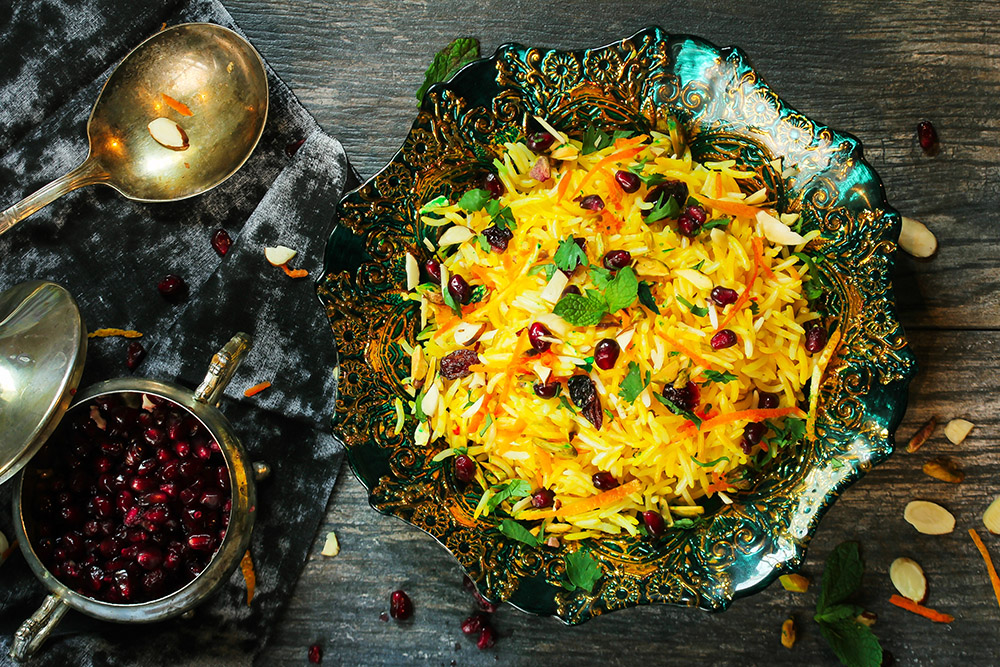
Armchair travel around the world!
Start your reading adventures with our FREE Reading Atlas.

- Around the World in 14 Books
- 7 Thrilling Book Series
- 6 Audiobooks That Are Like Theater For Your Ears



Food and drinks are some of the easiest ways — and the most fun— to vicariously experience another culture. When you add a great book to the mix, you've got the makings of a perfect evening. In Food+Fiction, we recommend a delicious read and a related recipe so you can try the taste of different destinations in your own kitchen.
This post is part of our Food+Fiction series.

The poignant memoir Searching for Hassan is about a man’s quest to find a cherished family friend in Iran. Author Terence Ward and his brothers grew up in 1960s Tehran under the watchful eye of Hassan, the family’s cook and the boys’ ‘Persian father,’ an unofficial and much-admired guide to all things Iranian.
This account of their adventures in Iran as adults is a travelogue, a celebration of Persian culture, an exploration of history, and a deeply personal journey into memory.
We’re honoring this moving, transporting book with a recipe that graces the table of celebrations in Iran: Persian Jeweled Rice.
This dish, often served on large platters at weddings and holidays, glistens with butter and sparkles with gem-colored fruits and nuts. Saffron, carrots, and orange peel are gold; barberries are rubies; pistachios are emeralds; almonds are pearls.
The rice is infused with saffron and fragrant spices — cinnamon, cardamom, allspice, cumin — as it steams. Then the bottom is toasted to form a golden, crisp crust. Each bite is a contrast of tender and crispy, sweet and tart, buttery and spicy. A bit like life, no?
About the barberries: Barberries are a tiny, tart fruit used in many Persian dishes. They can be found at Middle Eastern grocers and online, or you can replace them with another ruby-like, sweet-tart dried fruit like goji berries, dried cranberries, or dried sour cherries.

Serves 6. Total time 1 hour 15 minutes.
Soak the saffron and barberries. Place the saffron threads in 1/4 cup hot water and set aside. Soak the barberries and raisins in warm water for 10 minutes, then drain and set aside.
Prep the rice. Rinse the rice several times in cold water until the water runs clear, then drain. In a large pot, combine 12 cups of water and 2 tablespoons salt; bring to a boil. Add the rinsed rice and boil for 5 minutes, stirring occasionally. Drain the rice well in a colander and set aside.
Candy the orange peel and carrots. Use a vegetable peeler to remove the zest from the orange, then thinly slice the peel into lengthwise strips. Peel the carrots and cut into matchsticks. In a medium saucepan, bring the sugar and 1 cup water to a boil, stirring to dissolve sugar. Add the orange zest and carrots, reduce heat the heat to simmer, and cook, stirring occasionally, until carrots are tender, about 15–20 minutes; drain (discard syrup) and set aside.
Ready the jewels. In a medium skillet, heat 1 tablespoon butter over medium heat. Add the onion, sprinkle with a pinch of salt, and cook 4-5 minutes until it’s soft and lightly colored. Add 1 tablespoon of the saffron water and stir, then add the cinnamon, cardamom, allspice, black pepper, and cumin, and cook, stirring constantly until fragrant, about 1 minute. Reduce the heat and stir in the raisins and barberries; cook for 3 minutes, stirring often. Add the orange-peel-carrot mixture and set aside.
Layer the rice. Place 2 tablespoons butter in a heavy skillet or Dutch oven and warm over medium heat. Spread half the drained rice in the bottom of the pan, then spoon the onion-fruit mixture on top. Cover with the remaining rice. Using the end of a wooden spoon, poke 5–6 holes in rice all the way through to the bottom of the pot (to help release steam and help rice cook evenly). Keep the pan on the heat, uncovered, and cook for 5-8 minutes to gently brown the bottom of the rice. Attention: Don’t stir or otherwise agitate the rice; you want it to brown in the bottom of the pan. At this point, you must trust your nose; the rice will smell a bit toasty. This is when the delicious crust forms on the bottom.
Cook the rice. Drizzle the remaining saffron water over the rice and cover the pan with a lid. Adjust the heat to very low and let it cook undisturbed for 30 minutes. Then turn off the heat and let the rice rest, with the lid on, for an additional 10 minutes. Meanwhile…
Toast the nuts. Heat the remaining 1 tablespoon butter in a skillet over medium-low heat and toast the almonds and pistachios until slightly browned, about 1 minute. Set aside.
To serve, spoon the rice onto a platter and lift the bottom crust, breaking it into pieces and adding them to the serving platter. Sprinkle the whole shebang with the toasted nuts.
Pro tip: The fruit mixture can be made up to two days ahead if you want to break up this process. Store the fruit mix and the remaining saffron water in the fridge in separate containers, covered tightly. When you’re ready to cook, par-boil the rice (the step called ‘Prep the rice’) and jump to the step labeled ‘Layer the rice.’
Psst… That stunning building at the top of the post is the Shah Cheragh mosque in Shiraz, Iran.
I remember a brisk evening long ago. Fires glow red across the city’s roofline. Explosions of firecrackers break the spring silence. It is March 1963, the last Tuesday night before Nowruz, the Iranian New Year… Celebrations start at twilight. Hassan, our housekeeper, our cook, our young ‘Persian father,’ emerges from the shadows, swaying a glowing Coleman lantern and twitching his proud mustache. With the physique of a gymnast, he moves fluidly. His strong chin juts out with dramatic effect. He strides toward us, eyes flickering under the streetlamps. He bears the quiet nobility of an actor taking the stage. — Terence Ward
Author Terence Ward and his brothers grew up in 1960s Tehran under the watchful eye of Hassan, the family’s housekeeper, cook, and ‘Persian father,’ their unofficial and much-admired guide to all things Iranian. When the family left Iran for the United States, they lost touch with Hassan. Thirty years later, Ward’s family sets out on a quest through modern Iran to reconnect with the country they love and the dear friend that was left behind. {more}
This travelogue and memoir (368 pages) was published in March of 2020 by Tiller Press. The book takes you to Iran. David read Searching for Hassan and loved it; it wouldn't be on our site if he didn't recommend it.
Bookshop.org is an online bookstore with a mission to financially support independent bookstores and give back to the book community.
Top image courtesy of SJ Travel Photo and Video/Shutterstock.
Want to keep up with our book-related adventures? Sign up for our newsletter!
Can you help us? If you like this article, share it your friends!
Strong Sense of Place is a website and podcast dedicated to literary travel and books we love. Reading good books increases empathy. Empathy is good for all of us and the amazing world we inhabit.
Strong Sense of Place is a listener-supported podcast. If you like the work we do, you can help make it happen by joining our Patreon! That'll unlock bonus content for you, too — including Mel's secret book reviews and Dave's behind-the-scenes notes for the latest Two Truths and a Lie.
Join our Substack to get our FREE newsletter with podcast updates and behind-the-scenes info join in fun chats about books and travel.

We'll share enough detail to help you decide if a book is for you, but we'll never ruin plot twists or give away the ending.
Content on this site is ©2024 by Smudge Publishing, unless otherwise noted. Peace be with you, person who reads the small type.